If asked to name India’s only native ape species, what would come to mind? Certainly, the Hoolock Gibbon, more specifically the Hoolock Gibbon of Assam. This unique primate, rare and special, is crucial in Assam’s rich biodiversity. In this blog, we’ll explore the threats facing the Hoolock Gibbon of Assam, discuss how to save Hoolock Gibbon of Assam and highlight key conservation strategies that can make a difference.
Recognizing its importance and dwindling numbers, the people of Assam, along with conservationists across India, have taken proactive steps to protect the Hoolock Gibbon. Its significance has even led to the establishment of a dedicated wildlife sanctuary named in its honour- the Hollongapar Gibbon sanctuary. But are the Hoolock Gibbon of Assam safe?
Hoolock Gibbon of Assam
The Western Hoolock Gibbon is the only ape found in India. The species is protected under Schedule I of the Wildlife (Protection) Act and is listed as ‘Endangered’ on the International Union of Conservation of Nature (IUCN) Red List.
The name “Hoolock” has its roots in Assamese, where these apes are called “Holou Bandor” – with “Bandor” meaning monkey in Assamese (although they are not monkeys). Over time, “Holou” evolved into “Hoolock.” Some believe the name may also be linked to the Hollong tree, a tree fond abundantly in their habitat area.

Habitat of Hoolock Gibbons in Assam
Their distribution in Assam is believed to be restricted to the south of the river Brahmaputra. The species are protected in India in the Hollongapar Gibbon sanctuary, which support 125 individuals of the species (in 26 groups). Besides this, the species is found in Dehing Patkai National Park (situated in Dibrugarh and Tinsukia district) and Barekuri region in Tinsukia district.
However, fragmented population of the Hoolock Gibbons are also found in Kachijan village of Kakopathar in Tinsukia district (Kachijan Reserve Forest). They are also found in the Barajan Wildlife Sanctuary, Nalani Village No. 1 and Dangari forest in Tinsukia.
While efforts are being made to save Hoolock Gibbon situated in Hollongapar Gibbon sanctuary, little efforts are being made to save fragmented population scattered all over upper Assam.
Threats to Hollongapar Gibbon Sanctuary: A Closer Look
Since a large population of the western Hoolock Gibbon is located inside Hollongapar Gibbon Wildlife Sanctuary, we will first talk about it. It is to noted that the sanctuary is just 20.98 sq km. So, efforts to save Hoolock Gibbon of Assam must be in accordance with this small size of the sanctuary.
Encroachment by Human Habitat
The sanctuary is situated close to Jorhat city so there is tremendous pressure of human encroachment inside the sanctuary. Although it has been a restricted area for human activity and settlement since 1997, it is encircled by tea gardens and small villages. Consequently, the forest cover is isolated from other wildlife sanctuaries and the hilly terrains of the Patkai range, leaving the gibbons somewhat confined within this sanctuary. Their habitat faces ongoing threats from illegal logging and unauthorized human encroachment. As per data, habitat degradation have accounted for more than 40% decline in the Hoolock gibbon population in Assam in the last 30 years.
Railway Line and Electrification Project
A railway line (Lumding-Dibrugarh broad gauge railway section) already exists within the sanctuary, dividing one part of the park from the other. The Gibbons who rely on an unbroken canopy for movement and survival. They is strictly arboreal, which means it spends most of its life up in the trees, swinging along high canopies without setting foot on the forest floor for months. The railway track creates a canopy gap of up to 50 meters which is too large for gibbons to cross
Despite this, gibbons have adapted to the presence of the railway and cross it with minimal fear, resulting in rare fatalities. The nonprofit ‘Aaranyak’ and the Assam State Forest Department have also made efforts to build a natural canopy bridge.
However, Northeast Frontier Railway (NFR) is considering electrification and eventually double the track, which would overlap with the Eco-Sensitive Zone (ESZ) of the Hollongapar Gibbon Wildlife Sanctuary. Approximately 1.6 km of the electrification route would cut through the sanctuary, sparking protests from environmental activists. Electrification poses new risks, potentially leading to fatalities and increased stress among the gibbons, further fragmenting their habitat across the railway line.
Oil and Gas Exploration
A proposal was submitted seeking wildlife clearance for oil and gas drilling within the Dessoi Valley Reserve Forest, under the Jorhat Forest Division, which falls in the Eco-Sensitive Zone (ESZ) of Hollongapar Gibbon Wildlife Sanctuary. Following the recommendation of the State Board for Wildlife (SBWL), the Principal Chief Conservator of Forest (Wildlife), Assam, forwarded the proposal to the Centre for forest clearance. The project, led by Cairn Oil and Gas, involves the diversion of 4.49 hectares of forest land for drilling, which would further fragment the habitat of the Western Hoolock Gibbon. Environmental activists are protesting against this diversion. Hope that they succeed to thwart this move and help save Hoolock Gibbon of Assam.
Ways to Save Hoolock Gibbon of Assam
Identify Fragmented Populations: Conduct surveys to locate and map fragmented gibbon populations within the sanctuary. Assess habitat connectivity and movement patterns to understand how best to support population recovery.
Sensitize Local Communities: Engage with local communities around the sanctuary to raise awareness about the importance of Hoolock Gibbon conservation. Educate residents on the unique ecological role of the gibbons and the benefits of preserving their habitat.
Promote Co-Existence Strategies: Implement co-existence initiatives similar to Aaranyak’s success with the greater adjutant stork in Kamrup district. Encourage conservation-friendly practices that integrate community needs, helping people and wildlife to thrive together.
Prevent Habitat Encroachment and Degradation : Strengthen monitoring to prevent illegal logging and unauthorized settlements in the sanctuary. Involve local authorities and community members in patrolling and reporting activities that threaten the gibbon habitat.
Enhance Habitat Connectivity: Identify potential corridors to reconnect fragmented forest patches within the sanctuary, allowing for safer gibbon movement. Reforest degraded areas and establish canopy bridges to facilitate the gibbons’ natural movement across the sanctuary.

Efforts can be made to connect this isolated Sanctuary with nearby Reserved Forests (to the south) through land purchases.
Research and Development: Monitoring of gibbon groups through behavioural data collection in addition to camera traps and perhaps even population and genetic studies could lead us to more efficient method to save Hoolock Gibbon of Assam.
Further, the sanctuary can be developed as a tourist destination to promote and raise awareness about the species. This would do a world of good to save Hoolock Gibbon of Assam.











